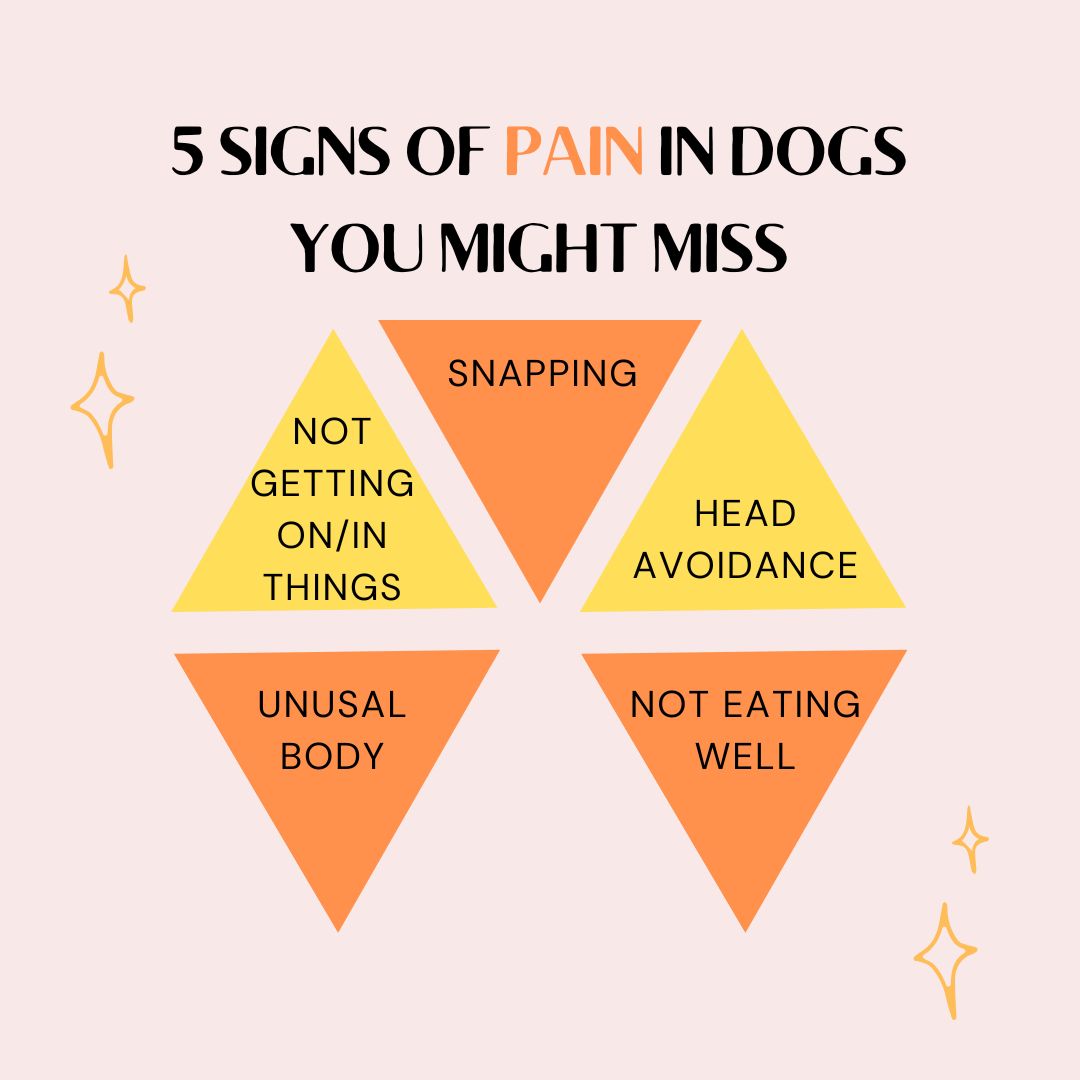5 Signs of Pain in Dogs You Might Miss

Pain often causes dogs to change their behavior in unexpected ways. A recent study found that people who better understand signs of pain in dogs are more likely to seek appropriate veterinary care (and sooner). Let’s look at 5 signs of pain in dogs you might miss. (Let me know what you would add to the list!) Also a real-life example at the bottom of the page.
Signs of Pain in Dogs
Most of us probably notice various behavior changes in our dogs, but we may interpret them as something other than pain.
1. Snapping or curling lips
Dogs snapping at their family or others may indicate a dog is in pain. Seems obvious, right? But recognizing the difference between straight-up fear snapping and pain snapping is harder. The big take away is that snapping or curling their lips could be a sign of pain in dogs, especially if they aren’t prone to such behavior. Because dogs experiencing pain likely don’t feel keen about being groped to find possible locations of pain, look for these other signs of pain below.
2. Head avoidance
Ear infections generate inflammation, itchiness, and pain in dogs. So, in addition to ear flapping and scratching, notice if your dog suddenly avoids being touched on the head or ears.
- It might be an ear thing.
- It also might be a dental pain thing.
- Or even some pain or trouble in the neck region.
3. Not eating well
Many of us assume that dogs not eating well means their tummies feel not great. However, it absolutely could be a pain thing — and not just dental pain. Dogs in pain may not want to eat much or at all, so pay attention to dogs:
- Eating slower than usual
- Eating less than usual
- Seeming hesitant about their food bowl (or food toys)

4. Unusual gait or body-at-rest positions
The study mentioned above found that a majority of people recognized a an unusual gait as a sign of pain in dogs, but what about unusual positions when at rest. Check your social feeds for photos of dogs doing funny things with their bodies and ask yourself, from now on, if maybe it’s the dog’s way of avoiding pain. In particular, pay attention to how they position their paws and wrists while lying down. If they curl them in weird ways (kind of under and back or to the side at the same time), that’s a sign of arthritis pain in dogs.
The photo above shows Tori in her classic belly-up position. Here I think she’s doing it just because, but she sleeps like this a LOT, especially in the evening on her bed or the loveseat. If she ever stopped doing this? I might worry about her being in pain.
5. Not jumping on / in things
I went to get a photo of a new dog bed with high sides as an example for this sign of pain in dogs post. I assumed it would be empty or feature someone other than Clover because Clover tends to avoid this new bed. I wonder if it means stepping over the high sides hurts her hips, but look what I found when I spun around at my desk?! Granted our day started with temps of -10 degrees, so everyone is snuggling!

Still … in recent years, Clover stopped jumping onto our bed most days. It’s pretty high, and she asks for help now. She *can jump up there, but she doesn’t. I assume it’s some arthritis (for which she takes supplements). She’s also a little slower to jump into “her chair” or other spots at times, but then often outside, she blasts around at high speed and leaps onto things nearly as high as our bed, so … maybe some of it’s context too. Not sure.
Other Signs of Pain in Dogs for This List?
Let me know what I missed so that I can add to this list of behaviors that may indicate pain in dogs.
- Maybe hiding?
- Maybe avoiding you?
- Maybe not playing, not wanting to go on walks, or sleeping a lot more than usual (though, really … how can you tell?! ha ha)
Also, would any of these cause you to make a veterinary appointment soon?
A real-life example: This discussion reminds me Clover’s subtle toe injury that came up in 2020. At agility classes, she started refusing the A-frame. She even started refusing the weave poles, and Clover LOVES weave poles. A slow-motion look at some video revealed the slightest hitch in her stride while weaving, then we noticed a limp, so I took her to the veterinary clinic for a pain assessment and x-rays, which revealed a condition that could become chronic. Clover took anti-inflammatory meds and rested for a long time. It’s why I retired her from agility rather than risk a chronic pain condition in her toe / foot!
